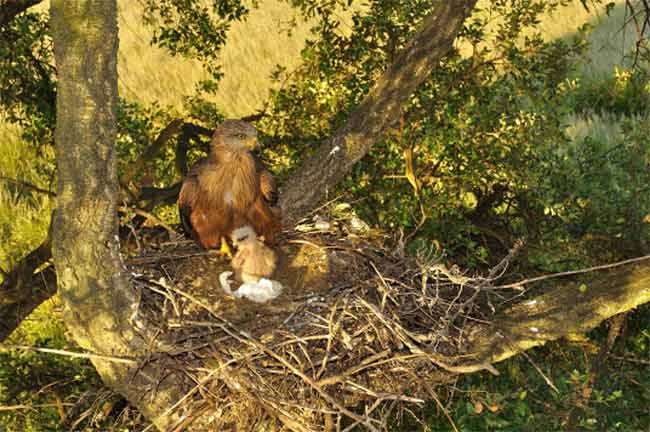To Safeguard Their Nests, Birds May Redecorate

Predatory birds called black kites have an unusual decorating style: They line their nests with bits of white plastic. Now, a new study suggests that this lining of litter may warn other birds that the owner of the nest is ready to fight.
Black kites are medium-sized raptors found across Europe and Asia. Males and females build nests together, lining the nests with white plastic right before the female lays her eggs. Before humans started leaving bits of trash around, the birds may have used feathers from other birds, said study researcher Fabrizio Sergio, a researcher at the department of conservation biology at the Consejo Superior de Investigaciones Científicas in Seville, Spain.
Or the behavior "could have even evolved after mankind came about," Sergio told LiveScience. "We really don't know."
Decorating with white
The researchers also weren't sure what the birds want with the white plastic. Other bird species and some fish use decorative objects or structures to attract mates. The Australian bowerbird male even builds a structure complete with an optical illusion to make himself look larger to potential mates. But kites decorate after they've paired up.
To unravel the mystery of the white plastic, Sergio and his colleagues observed a well studied, banded population of kites in Doñana National Park in Spain. The birds have been under observation for decades, and researchers have records on the ages of most of them.
First, the researchers recorded the level of decoration in 127 nests built by the raptors, a highly territorial species. They found that 77 percent of the nests had some decoration, which the birds began to add in the 20 days before laying eggs. Both males and females went plastic-scavenging. When the researchers provided a variety of colored plastics to choose from, the birds almost always turned up their beaks at every color except white.
Get the world’s most fascinating discoveries delivered straight to your inbox.
Birds at their reproductive peak were the most likely to decorate their nests with lots of plastic. When the researchers offered up extra plastic for birds that wanted it, 37 percent of the mated pairs refrained from collecting the plastic at all. These birds were either very old, very young, or in possession of poor-quality territory, Sergio said.
Kites sometimes vie for territory in mid-air fights, slashing each other with their sharp talons. These battles aren't for the weak, Sergio said.
Decoration-loving birds were more successful at fending off intruders and experienced fewer attacks overall, the researchers noticed. The same birds dominated when vying for food away from the nest, and their offspring had higher survival rates.
The researchers suspected that the birds might be using the plastic to make a statement about their high-quality territory and their ability to defend it – the bird equivalent of a "No Trespassing" sign backed up by the sound of someone loading a shotgun. To test the idea, Sergio and his team added extra white plastic to the birds' nests. They found that attacks initially increased, as if they'd painted a target on the nests. Dominant birds were usually able to fight off the attacks, but weaker birds weren't. In fact, they seemed desperate not to draw attention to themselves.
"We saw that some individuals were actually removing the decorations, and once again it was the very young and the very old," Sergio said.
{{ video="LS_110120_BirdNestBillboard" title="" caption="" }}
In a final experiment, the research team created fake nests stocked with chicken eggs. Some of the nests were lined with plastic, while others were plastic-free. Again consistent with the interpretation that plastic is a sign of bird wealth, the plastic-lined nests were burglarized and the eggs destroyed in 81 percent of cases compared with about 31 percent of plastic-free nests.
Sergio said the data point to white decorations as a territorial signal. When other birds see a sudden jump in white plastic, they test the truth of the signal: Is the bird bluffing? Can it really defend its plum location? If the nest-owners successfully show off their strength and defeat the intruders, the nest will be left alone.
Alternative explanation
Not everyone is convinced, however. The experiments were interesting, but the data could support another story, said Gerald Borgia, a professor of biology at the University of Maryland who was not involved in the study.
Instead of drawing attention to the nests with the white plastic, Borgia suspects the birds are trying to camouflage their white eggs.
"Eggs are vital things that parents want to take care of," Borgia told LiveScience. "To put a signal under eggs that would make them more visible, that seems very strange."
Instead, kites may use the white plastic to make it more difficult for aerial predators to see the eggs. Younger, older and weaker birds may have less plastic because dominant birds are better able to collect plastic or steal it from weaker birds, Borgia said.
Under this explanation, the increase in attacks on white-lined dummy nests would be because of kites swooping in to steal the unattended white plastic, Borgia said.
The researchers didn't notice any thieving, but observations were limited to in-person visits rather than constant video monitoring, Borgia said: "They need to do some kind of intensive monitoring to determine if there is stealing."
Sergio said the alternative explanation is "very unlikely," noting that hundreds of hours of observation had turned up no instances of thievery. Furthermore, he said, the birds that decorate their nests always lay eggs, while those that don't sometimes lay eggs and sometimes fail to breed. That makes the white plastic a bad camouflage strategy, Sergio said.
"Instead of concealing them, the birds that decorate could be giving away the information that there are eggs or there will soon be," Sergio said.
Sergio and his team plan to continue their observations of the kites and the birds' nest-decorating techniques.
You can follow LiveScience Senior Writer Stephanie Pappas on Twitter @sipappas.

Stephanie Pappas is a contributing writer for Live Science, covering topics ranging from geoscience to archaeology to the human brain and behavior. She was previously a senior writer for Live Science but is now a freelancer based in Denver, Colorado, and regularly contributes to Scientific American and The Monitor, the monthly magazine of the American Psychological Association. Stephanie received a bachelor's degree in psychology from the University of South Carolina and a graduate certificate in science communication from the University of California, Santa Cruz.


